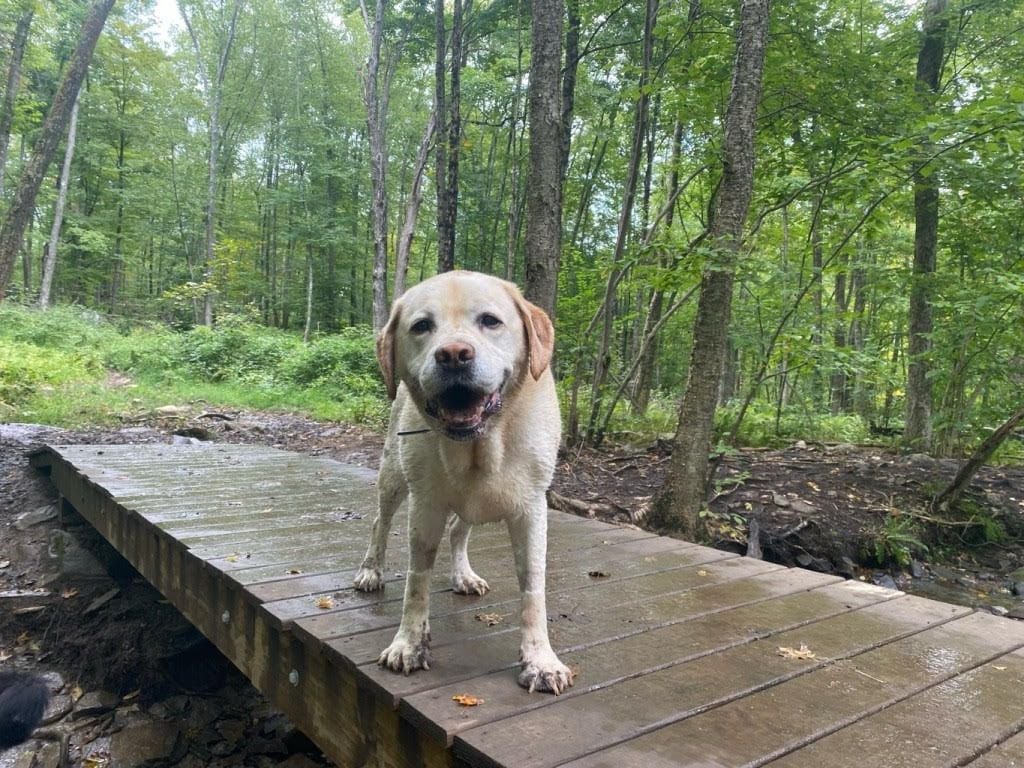Undifferentiated Oral Malignancy Case Study
History and Treatment Planning
A 12 year old, neutered male Golden Retriever, underwent a dental prophylaxis procedure performed by his primary care veterinarian in June of 2021. At that time, no suspicious lesions or growths were noted. In October 2021, his family discovered a marble-sized growth in his mouth along the gum line of his left maxilla. The mass was visible from the outside of his mouth, and seemed to cause him irritation. At the time, it was bloody (perhaps from self trauma/stick chewing). Antibiotics were prescribed, but the dog quickly developed worsening clinic signs (nasal discharge, swelling, lethargy).
Upon examination, his veterinarian described the mass as a large, inflammatory, proliferative mass present at 207/208 (spaces - teeth were absent having been removed during the dental), ulcerated and hyperemic. Swelling was present from under the left eye, to the gingival margin, to ~1cm medially on the hard palate. Due to significant concern for neoplasia, surgical biopsy and sedated skull radiographs were recommended. The mass was deemed inoperable (for complete excision), but potentially treatable with radiation or chemotherapy.
Skull radiographs showed no lytic regions or proliferative bony changes. Gingival overgrowth over space 207 was excised, and the mass at 208 was biopsied. In-house cytology showed multiple mitoses, pleomorphism of an abnormal round cell population, and multiple nucleolus. The patient did not have any indication of pulmonary metastasis on thoracic radiographs. Histopathology classified the mass as a poorly differentiated malignant neoplasia, most likely a carcinoma. Angiolymphatic invasion was not observed.
The dog's cancer journey continued with an oncologist on November 10, 2021, who detailed the dog's options for treatment which included surgery, radiation therapy, traditional chemotherapy, targeted therapy, autologous cancer vaccine, supplements and dietary management. Full staging was recommended, particularly in light of the enlarged mandibular lymph nodes discovered on exam. The dog was enrolled for FidoCure DNA Sequencing.
On November 17, abdominal and neck ultrasounds were performed. Fine needle aspiration cytology of the mandibular lymph node revealed possible metastatic carcinoma. His first and only dose of doxorubicin was administered.
Photos of Oral Cavity 11/17/21 - Pre Treatment



Precision Medicine Results and Treatment
On December 3, 2021, FidoCure Precision Medicine results were delivered to the dog’s oncologist. Sequencing revealed four mutations, KMT2C, N-RAS(2), PDGFRβ, two with potential therapeutic approaches (N-RAS(2)). Trametinib was indicated for treatment.
Gene: N-RAS Mutation: p.Gln61Arg
N-RAS is a single member of the RAS family of proteins involved primarily in regulating cell division. N-RAS belongs to a class of genes known as oncogenes that encode proteins and play important roles in cell division, cell differentiation and apoptosis. Activating N-RAS mutations lock the enzyme in an active state, causing increased cellular proliferation via hyper-activating MAPK and PI3K signaling pathways (Pylayeva-Gupta et al., 2011).
Somatic mutations in the N-RAS gene are involved in the development of several types of cancer. The Q61R mutation has been widely investigated in human malignant melanoma, as well as carcinomas, hematopoietic and lymphoid tumors (https://cancer.sanger.ac.uk/cosmic ). In dogs, the Q61R mutation has also been identified in hemangiosarcoma, oral melanoma and oral acanthomatous ameloblastoma (Wang et al., 2020; Peralta et al., 2019; Hernandez et al., 2018). In both species, this mutation is often associated with generalized therapeutic resistance, however, ongoing trials are exploring the benefit of both upstream (RTK) and downstream (MAPK/ERK or PI3K/AKT/mTOR) effector protein inhibition. Synergistic benefits of this association have also been demonstrated in vitro in canine melanoma (Wei et al., 2016).
The activation of K-RAS or N-RAS oncogenic variants in canine tumors can activate the RAS/RAF/MAP kinase signaling pathway and downstream targets ERK1/2 and AKT. In vitro, this is correlated with sensitivity to the MEK1/2 inhibitor trametinib (Das et al., 2019).
Gene: N-RAS Mutation: p.Glu63Gly
N-RAS is a single member of the RAS family of proteins involved primarily in regulating cell division. N-RAS belongs to a class of genes known as oncogenes, encode protein play important roles in cell division, cell differentiation and apoptosis. Activating NRAS mutations lock the enzyme in an active state causing increased cellular proliferation via hyperactivating MAPK and PIK2 signaling pathways (Pylayeva-Gupta et al., 2011).
Somatic mutations in the NRAS gene are involved in the development of several types of cancer. This specific mutation E63G has not been previously identified in dogs, but a similar mutation in humans (E63G) has been described in malignant melanoma with a pathogenic FATHMM prediction (score 0.99) and is confirmed as somatic mutation (https://cancer.sanger.ac.uk/cosmic ). FATHMM predicts whether single nucleotide variants (SNVs) in the human genome are likely to be functional or nonfunctional in inherited diseases.
Activation of KRAS or NRAS oncogenic variants in canine tumors can activate the RAS/RAF/MAP kinase signaling pathway and downstream targets ERK1/2 and AKT. In vitro this is correlated with sensitivity to the MEK1/2 inhibitor trametinib (Das et al., 2019).
The dog visited with his oncologist on December 8, 2021 and was reported to be doing well at home. Doxorubicin administration was discontinued, and Trametinib 0.2mg/kg/day (0.9mg q24) was prescribed. Concomitant medications being administered were Pregabalin, Carprofen, Maropitant (prn), Metronidazole (prn), and Sentesa hemp oil. The dog began Trametinib on December 9, 2021.
The patient experienced a rapid and significant response to targeted therapy. On December 28, 2021, his family reported to the oncologist that there had been a noticeable reduction in the size of the tumor and was doing very well with no adverse effects or new clinical signs.
“Great news…he seems to be doing very well with his chemo - no noticeable new symptoms. He had a great time opening presents and is acting like a puppy in the snow. It’s fantastic seeing him smile (yes he smiles ). My husband and I both have commented how we can’t see the tumor on his left cheek anymore.” Patient's pet parents
During his visit on January 5, 2022, his mass was discovered to be 50% smaller, and the notes gleefully declared that he was bossing the oncology staff around. Subsequent rechecks were positive, with a report on February 2, 2022: “There is a depression in the upper left quadrant of his mouth but the mucosa is smooth and normal looking.”
.png?width=500&height=333&name=How%20Mans%20Best%20Friend%20%26%20AI%20Cure%20Cancer%20(2).png)
“Thanks to Fidocure, he's being treated with trametinib which has worked wonders for him. His oral tumor has practically disappeared and his lymph nodes have shrunk by 50%. We started his treatment about 2 months ago. Mom and I couldn't be happier.” Patient's veterinary oncologist
In June 2022, when a restaging visit revealed no metastasis and he was in remission, Trametinib was discontinued. The dog had been experiencing worsening of his osteoarthritis, so Zoledronate infusions, acupuncture, and physical rehabilitation were started. On July 20, 2022, his medical record read “Patient's mouth looks great and his lymph nodes are normal,” though his OA continued to be very problematic. On July 27, 2022, thoracic radiographs, and pelvic and hindlimb radiographic studies revealed no sign of metastatic disease.
By September 7, 2022, the patient had experienced significant physical deterioration due to his OA. During a recheck visit, he was found to have enlarged prescapular and right popliteal lymph nodes with right hind lymphadenopathy, which was progressive and debilitating. Cytology of the right popliteal lymph node showed malignant neoplasia so they elected to restart Trametinib on September 8, 2022 at an increased dose.
The patient experienced worsening of his right hind lymphadenopathy with extreme difficulty ambulating. He was still eating and drinking. On September 20, 2022, ultrasound showed a paraneoplastic/metastatic neoplastic thrombus which was partially occluding the caudal vena and the likely cause of his hindlimb edema. The patient was treated with Clopidogrel.
Unfortunately, he continued to deteriorate and was euthanized October 19, 2022.


